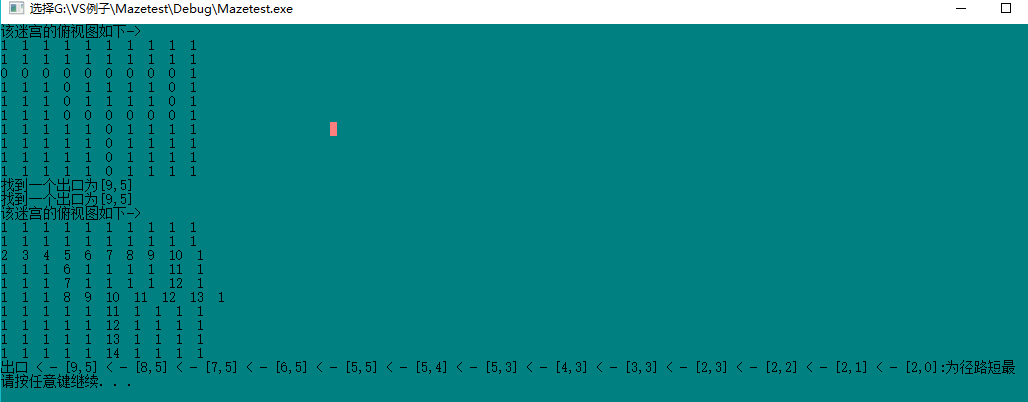迷宫问题
_____________________________________________
问题描述:给定一个二维数组如下所示,数值1位墙壁,0为可以走的通路,要求找到出口位置,并且找到最短的路径.
int arr[10][10] =
{
1, 1, 1, 1, 1, 1, 1, 1, 1, 1,
1, 1, 1, 1, 1, 1, 1, 1, 1, 1,
0, 0, 0, 0, 0, 0, 0, 0, 1, 1,
1, 1, 1, 0, 1, 1, 1, 0, 1, 1,
1, 1, 1, 0, 0, 0, 0, 0, 1, 1,
1, 1, 1, 1, 1, 1, 0, 0, 1, 1,
1, 1, 1, 1, 1, 1, 0, 0, 1, 1,
1, 1, 1, 1, 1, 1, 0, 0, 1, 1,
1, 1, 1, 1, 1, 1, 0, 0, 1, 1,
1, 1, 1, 1, 1, 1, 0, 0, 1, 1
};
{
1, 1, 1, 1, 1, 1, 1, 1, 1, 1,
1, 1, 1, 1, 1, 1, 1, 1, 1, 1,
0, 0, 0, 0, 0, 0, 0, 0, 1, 1,
1, 1, 1, 0, 1, 1, 1, 0, 1, 1,
1, 1, 1, 0, 0, 0, 0, 0, 1, 1,
1, 1, 1, 1, 1, 1, 0, 0, 1, 1,
1, 1, 1, 1, 1, 1, 0, 0, 1, 1,
1, 1, 1, 1, 1, 1, 0, 0, 1, 1,
1, 1, 1, 1, 1, 1, 0, 0, 1, 1,
1, 1, 1, 1, 1, 1, 0, 0, 1, 1
};
解决思想:
其实突然拿到该题真的无处下手,我们首先找到最短路径的时候首先就要走完通向出口的每一条路,但是我们走过的路
怎么样才能退回来呢?? 这个时候我们就要用试探法和回溯法合并使用了. 具体如何使用呢?? 来看下面这个图.

具体思想有了,然后现在呢我们思考一些细节的问题.
首先我们怎么样避免走回头路呢? 这个很容易想到就是对你走过的路程做一个标记. 然后每走一次将这个位置的数值置为
所走的步数,以后试探的时候,只需要判断下一个节点是否为0,或者它的数值是否大于自己,如果大于自己那么就继续走,
如果小于自己的值那么那个节点一定会是回头路. 所以这样的方法可以解决如下这种问题:
int arr[10][10] =
{
1, 1, 1, 1, 1, 1, 1, 1, 1, 1,
1, 1, 1, 1, 1, 1, 1, 1, 1, 1,
0, 0, 0, 0, 0, 0, 0, 0, 0, 1,
1, 1, 1, 0, 1, 1, 1, 1, 0, 1,
1, 1, 1, 0, 1, 1, 1, 1, 0, 1,
1, 1, 1, 0, 0, 0, 0, 0, 0, 1,
1, 1, 1, 1, 1, 0, 1, 1, 1, 1,
1, 1, 1, 1, 1, 0, 1, 1, 1, 1,
1, 1, 1, 1, 1, 0, 1, 1, 1, 1,
1, 1, 1, 1, 1, 0, 1, 1, 1, 1
};
{
1, 1, 1, 1, 1, 1, 1, 1, 1, 1,
1, 1, 1, 1, 1, 1, 1, 1, 1, 1,
0, 0, 0, 0, 0, 0, 0, 0, 0, 1,
1, 1, 1, 0, 1, 1, 1, 1, 0, 1,
1, 1, 1, 0, 1, 1, 1, 1, 0, 1,
1, 1, 1, 0, 0, 0, 0, 0, 0, 1,
1, 1, 1, 1, 1, 0, 1, 1, 1, 1,
1, 1, 1, 1, 1, 0, 1, 1, 1, 1,
1, 1, 1, 1, 1, 0, 1, 1, 1, 1,
1, 1, 1, 1, 1, 0, 1, 1, 1, 1
};
大致思想已经明白了,最重要的代码实现如下:
代码实现:
#include<iostream>
#include<Windows.h>
#include<assert.h>
#include<stack>
using namespace std;
struct pos
{
pos(int i,int j)
:row(i)
,col(j)
{}
int col;
int row;
};
template<int M,int N>
class maze
{
public:
maze(int array[M][N])
{
for (int i = 0; i < M; i++)
{
for (int j = 0; j < N; j++)
{
arr[i][j] = array[i][j];
}
}
}
maze(const maze& T)
{
for (int i = 0; i < M; i++)
{
for (int j = 0; j < N; j++)
{
arr[i][j] = T.arr[i][j];
}
}
}
void printminmazepath()
{
pos cur(0,0);
cout << "出口:";
while (!q.empty())
{
cur = q.top();
cout<<" < - " << "[" << cur.row << "," << cur.col << "]";
q.pop();
}
}
void getmazepath(pos enter,int count)
{
pos cur = enter;
pos next = cur;
arr[enter.row][enter.col] = count+1;
p.push(cur);
if (cur.row == N - 1)
{
if (q.empty() || q.size() > p.size())
{
cout << "找到一个出口为" << "[" << cur.row << "," << cur.col << "]" << endl;;
q = p;
}
cout << endl;
}
//向上试探
next.row -= 1;
if (CheckAccess(cur, next))
{
getmazepath(next, arr[cur.row][cur.col]);
}
//向右试探
next = cur;
next.col += 1;
if (CheckAccess(cur, next))
{
getmazepath(next, arr[cur.row][cur.col]);
}
//向下试探
next = cur;
next.row += 1;
if (CheckAccess(cur, next))
{
getmazepath(next, arr[cur.row][cur.col]);
}
//向左试探
next = cur;
next.col -= 1;
if (CheckAccess(cur, next))
{
getmazepath(next, arr[cur.row][cur.col]);
}
p.pop();
return;
}
bool CheckAccess(pos cur,pos next)
{
if ((next.row >= 0 && next.row < M)
&& (next.col >= 0 && next.col <= N)
&& (arr[next.row][next.col] == 0 || arr[cur.row][cur.col] < arr[next.row][next.col]))
{
return true;
}
return false;
}
void print()
{
cout << "该迷宫的俯视图如下->" << endl;
for (int i = 0; i < M; i++)
{
for (int j = 0; j < N; j++)
{
cout << arr[i][j] << " ";
}
cout << endl;
}
}
private:
int arr[M][N];
stack<pos> p;
stack<pos> q;
};
void Test()
{
int arr[10][10] =
{
1, 1, 1, 1, 1, 1, 1, 1, 1, 1,
1, 1, 1, 1, 1, 1, 1, 1, 1, 1,
0, 0, 0, 0, 0, 0, 0, 0, 0, 1,
1, 1, 1, 0, 1, 1, 1, 1, 0, 1,
1, 1, 1, 0, 1, 1, 1, 1, 0, 1,
1, 1, 1, 0, 0, 0, 0, 0, 0, 1,
1, 1, 1, 1, 1, 0, 1, 1, 1, 1,
1, 1, 1, 1, 1, 0, 1, 1, 1, 1,
1, 1, 1, 1, 1, 0, 1, 1, 1, 1,
1, 1, 1, 1, 1, 0, 1, 1, 1, 1
};
maze<10,10> arr1(arr);
arr1.print();
arr1.getmazepath(pos(2,0),1);
arr1.print();
arr1.printminmazepath();
system("pause");
}运行结果:























 1万+
1万+











 被折叠的 条评论
为什么被折叠?
被折叠的 条评论
为什么被折叠?








